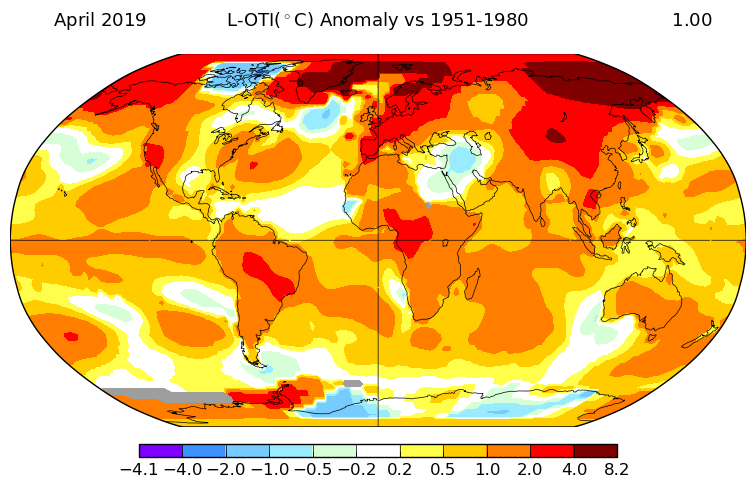April 2019 Second-Hottest April On Record; Globally .99 C Above Mid-20th Century Averages
EDIT
According to NASA GISS, global temperatures have again jumped into near record hot ranges. Readings from this key global monitor found that April of 2019 hit 0.99 degrees Celsius above mid 20th Century ranges. This is about 1.21 C above 1880s values that bound the start of the NASA monitor. In total, it’s a value that makes April of 2019 the second hottest such month in the 139 year global climate record. And the temperatures we are experiencing now are likely the hottest annual and decadal averages in the last 120,000 years.
 ?w=600&h=387
?w=600&h=387
(April of 2019 anomalies paint a picture of global heat. Image source: NASA.)
Looking at the NASA temperature anomalies map above we find the greatest departures from typical April averages centering on the higher latitudes of the Northern Hemisphere. This distribution of abnormal warmth is consistent with polar amplification in which relative warming tends to center on the poles as atmospheric greenhouse gas concentrations increase. The ongoing and massive burning of fossil fuels — beginning in the 18th Century and rapidly ramping through the 20th Century — has provided the majority of these gasses. They are pushing the Earth system into the severe warming spike we now see today.
The Equatorial region also showed elevated heat — consistent with an ongoing weak El Nino (which also nudges Earth into the warm side of natural variability, making regional and global all time heat records more likely). Meanwhile, very few cool pools were found. The notable region being a persistent cool zone in the North Atlantic near melting Greenland (predicted by climate models and a facilitator of unstable weather for North America, the Northern Atlantic, and Europe).
EDIT
https://robertscribbler.com/2019/05/21/nasa-april-of-2019-was-second-hottest-on-record/
 ?w=600&h=387
?w=600&h=387